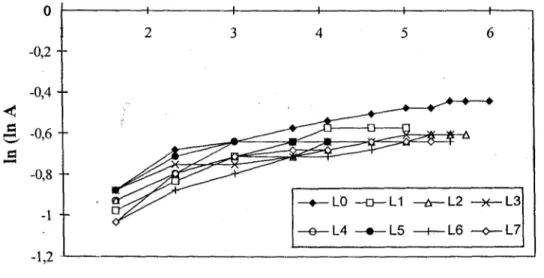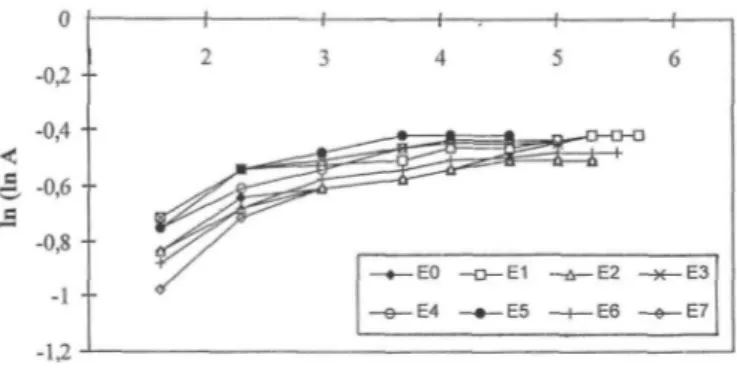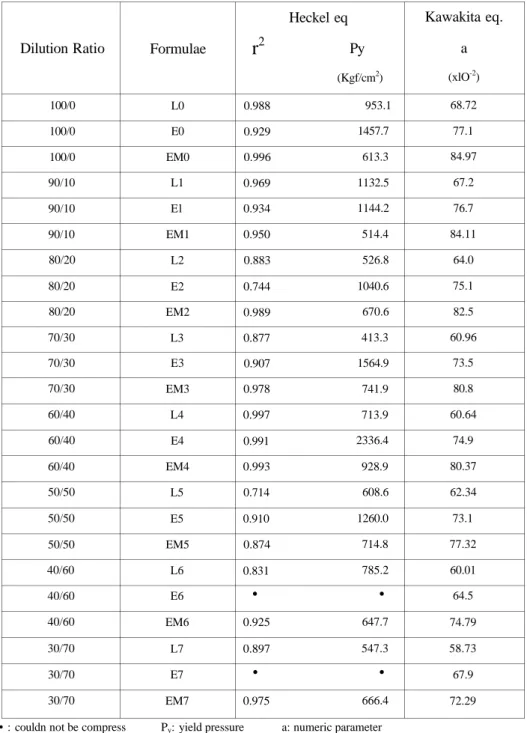29(1)21-30,2000 29 (1) 21-30,2000
T H E P A R A M E T R I C A L I N V E S T I G A T I O N O F T H E D I L U T I O N P O T E N T I A L S O F S O M E D I R E C T C O M P R E S S I O N AGENTS*
B A Z I D O Ğ R U D A N B A S I M A J A N L A R I N I N D İ L Ü S Y O N P O T A N S İ Y E L L E R İ N İ N P A R A M E T R İ K OLARAK İ N C E L E N M E S İ
Yalçın ÖZKAN* Yıldız ÖZALP** Efsun DUMAN** Tamer BAYKARA**
*Gülhane Military Medical Academy, Department of Pharmaceutical Technology, 06018 Etlik-Ankara, Turkey
**Ankara University, Faculty of Pharmacy, Department of Pharmaceutical Technology, 06100Tandoğan-Ankara, Turkey
ABSTRACT
The investigation of the excipient properties for Direct Compression (DC) is one of the important steps for the formulation development. The consolidation and the compression properties are compared for Elcema G 250®, Ludipress* and Emcocef which are used as DC agents. For this purpose, the formulations are diluted by Lactose EP D-30.
It was found that, Emcocel has the highest dilution potential, according to the results obtained from ln(ln Tapp), Heckel and Kawakita equations in all formulations.
Key words: Direct compression agents, Direct compression, Dilution potential
ÖZET
Doğrudan basımda kullanılan yardımcı maddelerin incelenmesi, formülasyon geliştirmede önemli aşamalardan biridir. Doğrudan basım ajanı olarak kullanılan Elcema G 250s, Ludipress* ve Emcocel®'in konsolidasyon ve basılabilme özellikleri karşılaştırılmıştır. Bu amaçla
formülasyonlar Laktoz EP D-30 ile dilüe edilmiştir. Tüm formülasyonlarda, ln (ln Tapp), Heckel ve Kawakita eşitliklerinden elde edilen sonuçlara göre en yüksek dilüsyon potansiyelinin Emcocel ile elde edildiği bulunmuştur.
Anahtar Kelimeler: Doğrudan basım ajanları, Doğrudan basım, Dilüsyon potansiyeli
INTRODUCTION
In the direct compression process, the factor ensuring compressibility is the additive ratio of DC agents. In other words, it is the carrier capacity of DC agents for the other tableting ingredients including the active substance. The compressibility of each DC agent depends on the technological properties of active substance and the other ingredients in the formulation. Particle size and distribution, particle shapes, bulk density and tapped density change the additive ratio of DC agents.
The additive ratio between the DC agents and the other ingredients in compression mass or the carrier capacity of DC agents is defined as "Dilution Potential" (1). This nonparametrical expression should be described quantitatively. Therefore Py values are determined by Heckel equation and the compressibility properties are evaluated according to the results obtained (2).
In this study, different dilutions of Elcema G 250, Ludipress, Emcocel used as DC agent were prepared with Lactose EP D-30 and evaluated by the parametrical changes in their compressibility properties.
EXPERIMENTAL Materials
Elcema G 250®, powdered cellulose (Degussa, Germany); Ludipress®, 93.4 % -lactose monohydrate / 3.2 % polyvinylpyrolidone / 3.4 % crospovidone (BASF, Germany); Emcocel®, microcrystalline cellulose (Mendell, USA); Lactose EP D-30 (Meggle GmbH, Germany).
Table 1. Dilution ratio of components in the formulation
Components
Ludipress / Lactose EP D-30 Elcema / Lactose EP D-30 Emcocel / Lactose EP D-30
Dilution Ratio of the Components 100/-L0 E0 EM0 90/1 0 L1 El EMI 80/2 0 L2 E2 EM2 70/3 0 L3 E3 EM3 60/4 0 L4 E4 EM4 50/5 0 L5 E5 EM5 40/60 L6 E6 EM6 30/70 L7 E7 EM7 Methods
Three direct compression (DC) agents and their formulations are shown in Table 1. Mixing operations of the formulae were performed using the cubic mixer (Erweka, 15/UG) for 20 minutes at a speed of 20 ± 1 rpm.
Determination of Consolidation Properties of Powders
For the consolidation property, a 10 ml graduated cylinder and also, in order to avoid percolation, a funnel was used. After weighing the 10 ml powder, the bulk density (BD) was calculated. And for the tapp density, the graduated cylinder was tapped from a height of 20 mm and the resulting reduction in volume was measured after repeating this procedure 5, 10, 20, 30, 50, 75, 100, 125, 175, 200, 300, 400 times.The natural logaritmus of the tapping values In (Tapp), thus obtained were plotted against the In (In A), using eq.l (3). The parameters of regression lines calculated with a computer programme (Basic 80) were investigated (4).
TD-BD
A= (eq. 1) TD
Determination of the Compressibility of Powders
Powders were compressed with different pressure values. For this purpose, flat-face punch of 12 mm diameter and hydraulic press were used. Equal volumes of powders (1357.17 mm3) were compressed at 767.0, 1150.5, 1535.0, 1917.0, 2301.5 and 3068.1 kgf/cm2 (5-9). Reaching the desired pressure it was kept at the required value for 30 sec (10). The volume of the tablet; Vp, formed at each pressure level was calculated. Results were calculated with a computer programme written by using Heckel and Kawakita equations (4). The experiments were repeated for 3 times at each pressure level and data and tapping process which did not fit within the 95 % probability level range were eliminated according to Dixon Massey test (11).
The Heckel eq. is:
V V
V p V o
In = k P + (eq.2) V -V V -V
Vo: Initial powder volume; Vp : The volume at each pressure value;
V8: The true volume of the solid (without pores); k: Constant. Heckel correlated the slope of the compaction curves, k, with the yield strength of the material being compessed (k=l/ Py); and Py: yield pressure.
The Kawakita eq. is:
Vo-Vp abP --- = (eq.3) Vo 1 +bP or, P 1 1 — = + xP (eq.4) C a b a
C : Degree of volume reduction (Vo - V p / Vo = C ) ; Vo : Initial apparent volume of
powder;
Vp : Powder volume under applied pressure (P) ; and a , b are constants , characteristic of
the powder.
In the Kawakita eq., "a" is a numeric parameter indicating the initial porosity of the compressed powder mass and "b" is the compression coefficient (7).
RESULTS AND DISCUSSION
Consolidation properties of mixed powders which were prepared from eight different dilutions with each DC agent show changes (Fig.l, Fig.2, Fig.3) depending on the accomodation of the size of the DC agents.
0
In (Tapp)
Figure 1. Consolidation of dilutions with Ludipress
All the formulations' intercept values began to change from low dilution values, but this change was generally similar to each other in the high dilution values (Fig.2).
In (Tapp)
Figure 2. Consolidation of dilutions with Elcema G 250
At the dilutions that were prepared with Elcema G 250, the reason why the initial and the highest dilution values' consolidation differences were too similar to each other was that the particle size of Elcema G 250 and Lactose EP D-30 was not close to each other. Although placing of the fine lactose EP D-30 particles into the porous of the granulated form Elcema G 250 particles caused an increase in the number of tapping at the consolidation, the linearity was not obtained. In the case of Ludipress (Fig.l), for all the dilution values, profiles of very close slope values were obtained. It was because Ludipress which has nearly all spherical particles was diluted with Lactose EP D-30 that has also spheric particles and has no extreme difference in the particle size. Consequently, it was obtained steady lineer parameters for different dilution
ratios.
In (Tapp)
Figure 3. Consolidation of dilutions with Emcocel
For Emcocel, the linearity was at last obtained after the third dilution, between EM4-EM8. At the first three dilutions (EM1,EM2,EM3) as the particle size of Emcocel is more fine than Lactose EP D-30, the profiles merely became linear after 30 tapping (Fig.3). This result shows
us that for the compression of DC agents with Emcocel, there will be an energy loss in the compression stage. Due to the spherical particles of Ludipress, this attitude was not found and the energy loss in the consolidation was found lower than the others in the compression stage. This situation for Elcema was starting after 10 tapping (12,13).
Table 2. Compression parameters of dilutions
Dilution Ratio 100/0 100/0 100/0 90/10 90/10 90/10 80/20 80/20 80/20 70/30 70/30 70/30 60/40 60/40 60/40 50/50 50/50 50/50 40/60 40/60 40/60 30/70 30/70 30/70 Formulae L0 E0 EM0 L1 El EM1 L2 E2 EM2 L3 E3 EM3 L4 E4 EM4 L5 E5 EM5 L6 E6 EM6 L7 E7 EM7
r
2 0.988 0.929 0.996 0.969 0.934 0.950 0.883 0.744 0.989 0.877 0.907 0.978 0.997 0.991 0.993 0.714 0.910 0.874 0.831 • 0.925 0.897 • 0.975 Heckel eq Py (Kgf/cm2) 953.1 1457.7 613.3 1132.5 1144.2 514.4 526.8 1040.6 670.6 413.3 1564.9 741.9 713.9 2336.4 928.9 608.6 1260.0 714.8 785.2 • 647.7 547.3 • 666.4 Kawakita eq. a (xlO-2) 68.72 77.1 84.97 67.2 76.7 84.11 64.0 75.1 82.5 60.96 73.5 80.8 60.64 74.9 80.37 62.34 73.1 77.32 60.01 64.5 74.79 58.73 67.9 72.29 • : couldn not be compress Py: yield pressure a: numeric parameterThe lowest Py value was obtained with Emcocel when there was no dilution, compression with pure DC agent. This value is the highest (1457.7 kgf/cm2) while using Elcema G 250 (Table 2). With increasing the dilution ratios in Ludipress, this value began to increase but after it again decreased to the low values. Therefore, with the Ludipress dilutions, there was not harmonious increase in Py values. However it was observed that at the linearity processes by Heckel equation, the r2 values (starting from 0.998 to 0.714 in L5) for Ludipress decreased from the beginning for all dilutions. This disappearence of the linearity showed that calculated Ludipress Py values according to Heckel equation was causal. From the beginning, although the compression values of pure Emcocel were high, it didn't change till to the E3 formula (E3; 80/20). The Py values in E4 and E5 rose up and at this variation, Heckel r2 value was not found at its initial value. The E6 and E7 formulations could not compressed. This showed us that Elcema was compressed from the beginning till to the dilution of 60/40 (E4) without a problem but when the dilution ratio was 50/50 (E5), the dilution potential was passed over. Emcocel, in the Heckel equation, without a variation in the linearity, in all dilutions, continuing the close Py values to the initial Py value of 613.3 kgf/cm2 reached the value of 666.4 kgf/cm2 for formulation EM7. This means that Emcocel has a high carrier capacity than its dilution with Lactose EP D-30 at the ratio of 30/70 (EM7). When DC agents are considered to change according to the ratio of the ingredients being loaded by the dilution potentials and the powder technological properties in the Research and Development stage, dilution potential should be fixed according to the additive ratio or dilution of active agent(s) and the other ingredients included in the formulae and these parameters should be transfered to the production stage with their tolerances.
The initial porosity of powder mixtures which are shown as a numerical value, known as Kawakita "a" values are constant before dilution. The increase or decrease of this value by dilution was changed depending on the difference of the particle sizes of DC agent and dilution agent (Lactose EP D-30) (Table 2).
CONCLUSION
As a result, among the investigated three DC agents; Emcocel was the one that had a steady concentration and the least changed compression property while dilution ratio had been increased. This result is related to the particle size and distribution of dilution agent. The other two DC agents can be used with a dilution agent which has a different particle size and distribution other than Lactose EP D-30.
REFERENCES
1. Yacoub, H., Augsburger, L., Reier, G., Wheatley, T., Shangraw, R., " Dilution Potential: A new Perspective", Pharmaceutical Development and Technology, 1 (2), 205-212 (1996).
2. Paronen, P., " Heckel Plots as Indicators of Elastic Properties of Pharmaceuticals", Drug Dev. Ind. Pharm., 12 (11-13), 1903-1912 (1986).
3. Baykara, T., Duman, G., Süleyman, M.M., "Stampf Kompressions Eigenschaften von Pharmazeutischen Pulvern und Pressmassen", 49th International Pharm. Sci.
Congress of FIP, Munich, September 9-11, p.167 (1989).
4. Süleyman, MM., Baykara, T., A microcomputer programme series for use in tablet technology, in 3rd International Pharmaceutical Technology Symposium, Ankara,September 9-11, p. 89 (1986).
5 . Heckel, R.W.," Density-Pressure Relationships in Powder Compaction", Transactions of The Metallurgical Society of Aime, 221,671-675 (1961).
6. Parrott, E.L., " C o m p r e s s i o n " , in Pharmaceutical Dosage Forms: Tablets
(Lieberman H.A.and Lachman,L.(Eds), Marcel Dekker Inc., New York, Vol.2, p. 154 (1981).
7. Sheikh-Salem, M, Fell, J.T., "The Influence of Initial Packing on the Compression of
8. Lüdde, K.H., Kawakita, K., "Die Pulverkompression",Die Pharmazie, 7, 393-403 (1966).
9. Özkan, Y., Özalp, Y., Baykara, T., "Development of Tablet Formulation of Acetaminophen with Direct Compression Method", J.Fac.Pharm.Gazi, 8 (2), 101-109 (1991).
10. Marshall, K., "Monitoring Punch Forces and Punch Movements as an Aid to Developing Robust Tablet Formulations" Drug Dev. Ind. Pharm., 15 (13), 2153 -2176 (1989).
11. Hinchen, J.D., in Practical Statistics for Chemical Research, Methuen and Co., Ltd., London E.C.4, p. 26-28 (1969).
12. List, P.H., Arzneiformenlehre, Wissenschaftliche Verlagsgesellschaft GmbH, Stuttgart, p. 96 (1985).
13. Ragnarsson,G., in Pharmaceutical Powder Compaction Technology (Alderborn G. and Nyström, C. (Eds.), Marcel Dekker, Inc., New York, 80 (1996)



